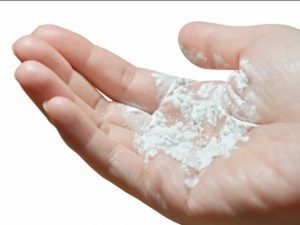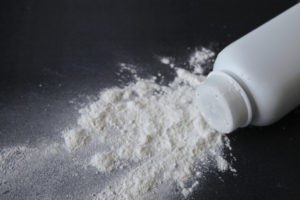New Developments in Product Liability Law: Talc and Ovarian Cancer
Written by: Shepard Law Firm Staff
Talcum powder and baby powder are well-known products that the average consumer would have little concern with using on a regular basis. However, new information has recently arisen that links the regular use of talcum powder to ovarian cancer in women.
Manufacturers of talcum powder products and companies that mined and supplied talc have previously faced lawsuits over allegations that the mines from which their talc originated was also contaminated with asbestos. When regular users of these talc products (or workers in factories and mines who were regularly exposed to talc) developed lung cancer or mesothelioma, the cause of the disease was the asbestos contamination, not the talc itself.
In the most recent wave of cases against manufacturers of talcum powder products such as Johnson & Johnson, the allegation is that the talc itself is the carcinogen. Over the past year, a number of women have filed lawsuits against Johnson & Johnson, claiming that they have developed ovarian cancer as a result of their regular use of Johnson & Johnson’s baby powder. These cases allege that Johnson & Johnson knew that its Baby Powder and Shower to Shower Powder talc products cause ovarian cancer, and failed to warn women who used these products of the potential dangers.
While litigation against asbestos product manufacturers on behalf of individuals with mesothelioma or lung cancer has been going on for decades, litigation involving talc and ovarian cancer is a very recent development. When a large number of cases are filed based on a new legal theory, courts will often conduct what are known as bellwether trials to test the merits of the plaintiff’s claims and create a range of likely jury verdicts. As the medical link between talc exposure and ovarian cancer is not nearly as well-documented as the link between asbestos exposure and mesothelioma, these bellwether trials will be very important for existing as well as future claims made by women who develop ovarian cancer as a result of exposure to talc products. Judges that oversee groups of cases can conduct these bellwether trials in a variety of manners.

At least two juries have found Johnson & Johnson liable and returned 8-figure verdicts in early bellwether trials.
- In February 2016, a Missouri jury awarded $72 million to the family of a woman who died from ovarian cancer after using Johnson & Johnson talc products for more than three decades. This verdict included $62 million in punitive damages, meant to punish Johnson & Johnson for the jury’s findings that the company knew about the cancer risks from its products for decades but failed to provide warnings to its customers or to the medical community.
- In May 2016, another Missouri jury awarded $55 million in damages (including $50 million in punitive damages) to a woman who developed ovarian cancer after using Johnson & Johnson’s talc products for nearly 40 years. After undergoing a hysterectomy, talc was found in the plaintiff’s ovarian tissue. Once again, the jury found that Johnson & Johnson knew that its products caused ovarian cancer, and failed to warn users of the danger.
While the ovarian cancer litigation against Johnson & Johnson and other manufacturers of talc products is still in its early stages, these recent cases show that the medical link between use of talc products and the development of ovarian cancer is strong enough to result in favorable plaintiff’s verdicts. If you or a close family member have developed ovarian cancer and are a regular user of these products, please do not hesitate to contact us for a free consultation.
Close to home: How Asbestos Hides in Unlikely Places and Products
Written by: Shepard Law Firm Staff
When most people think of asbestos, they picture a dark and dusty industrial building, a power plant with insulated steam pipes, or an old, noisy boiler in a basement of a run-down school. Because of these pre-disposed beliefs about what asbestos is and where it is found, the average person that did not work in an industrial trade is likely to think they have never come into contact with asbestos.

Few people realize that asbestos can hide in other places and products besides factories.
But asbestos can be found in unlikely places and products. For instance, most people are unaware that everyday beauty products such as baby powder and talcum powder were at times contaminated with deadly asbestos fibers. A number of lawsuits have been brought by individuals who used the Cashmere Bouquet brand scented talcum powder for a number of years, and later developed mesothelioma or other asbestos-related diseases. How can talcum powder contain asbestos? The connection between talc and asbestos is due to the close proximity of the two minerals in many areas of the earth’s surface. Tremolite, which is a type of asbestos fiber, is frequently found in the same areas where other minerals are mined, particularly vermiculite and talc. Mines that produced talc have often been found to also have tremolite asbestos fibers in the area from which the talc was being mined. In addition to causing asbestos-related diseases such as mesothelioma and lung cancer, there is also evidence that regular use of cosmetic talc may cause ovarian cancer in women.
Additionally, anyone who was involved with a home renovation project in the 1970’s or earlier likely worked with some type of asbestos containing product. Many building products in the late 1970’s and early 1980’s such as roofing shingles, floor tile, and joint compound contained asbestos fibers. Roofing shingles and floor tile would often have to be cut to size, which created dangerous asbestos dust. If you performed any home renovation work involving drywall or sheetrock during this time period, it is likely that joint compound was applied between sections of the new walls. And because most joint compound contained asbestos fibers until approximately 1980, when the joints between the walls were sanded, asbestos dust would be created.
As you can see, even if you never worked in an industrial trade or at a commercial facility, you may have been exposed to asbestos through a variety of different products, including products that are in our homes. And because many people forget how small asbestos fibers are, they underestimate the dangers of exposure. Check out the size comparison at this site to see just how small asbestos fibers are. And if you or a loved one has been diagnosed with an asbestos related disease, please contact one of our attorneys.

